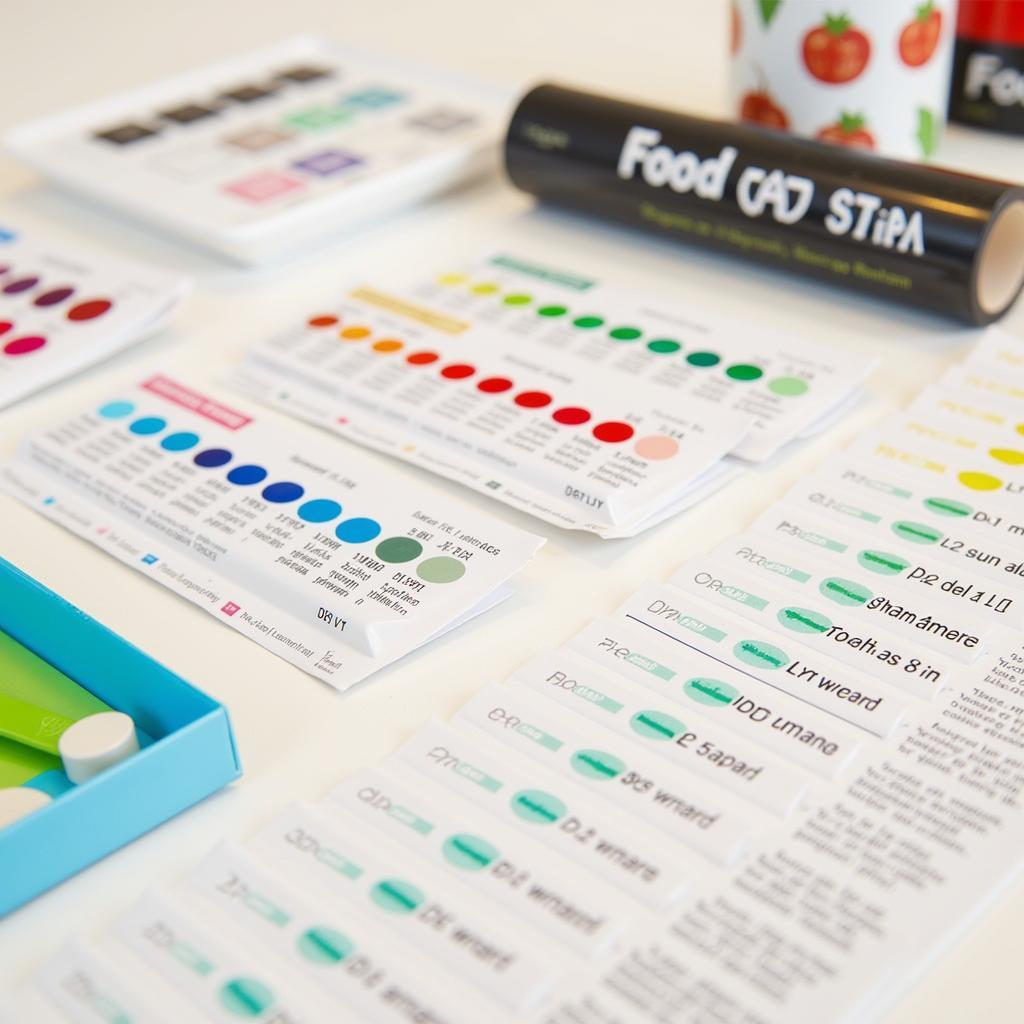Understanding the pH level of your food can be crucial for various reasons, from ensuring food safety and quality to optimizing fermentation processes. Food Ph Test Strips offer a convenient and effective way to achieve this. These handy tools allow you to quickly determine the acidity or alkalinity of your culinary creations, empowering you to make informed decisions about preparation, preservation, and even taste.
Getting the right pH is crucial for safe canning. Incorrect pH levels can lead to botulism, a severe form of food poisoning. Using food pH test strips gives you confidence that your preserved foods are safe to enjoy. They’re also incredibly helpful when fermenting foods like sauerkraut or kimchi. Accurate pH measurement is essential for a successful ferment and prevents unwanted bacterial growth. Want some inspiration? Check out these DIY Pokemon party food ideas.
What are Food pH Test Strips?
Food pH test strips are small, disposable strips of paper treated with pH-sensitive dyes. When dipped into a food sample, these dyes change color depending on the pH level. By comparing the resulting color to a color chart provided with the strips, you can easily determine the pH of the food. This is a quick and easy way to ensure your food is at the correct acidity or alkalinity for optimal safety and taste.
Why is pH Important in Food?
pH plays a vital role in food safety, quality, and taste. A food’s pH level influences its susceptibility to microbial growth, enzymatic activity, and even its texture and flavor. For example, acidic foods (low pH) are less prone to bacterial growth, which is why pickling and fermenting are effective preservation methods. Understanding pH is essential for home cooks and professional chefs alike. Knowing the pH of your ingredients can help you anticipate how they will react during cooking and adjust your recipes accordingly. For instance, knowing the acidity of your tomatoes can significantly impact the outcome of your pasta sauce. Need a change of cuisine? Take a look at the Los Altos Mexican Food Menu.
How to Use Food pH Test Strips Effectively
Using food pH test strips is simple. First, take a small sample of the food you want to test. If the food is solid, blend or mash it with a small amount of distilled water to create a slurry. Next, dip a test strip into the sample for a few seconds. Remove the strip and compare the color change to the color chart provided. The chart will correlate the color to a specific pH value. For more complex food preparation, understanding pH can be particularly relevant. You might find this information helpful when planning your best turkey food plot.
Different Types of Food pH Test Strips
While the basic principle remains the same, food pH test strips are available in various ranges and sensitivities. Some strips offer a broad range, while others are designed for specific pH ranges relevant to particular foods or processes, like winemaking or cheesemaking. Choosing the right type of strip ensures accurate and meaningful results.
 Different Types of pH Test Strips for Food Testing
Different Types of pH Test Strips for Food Testing
Are Food pH Test Strips Accurate?
Food pH test strips generally provide a reliable indication of a food’s pH level. However, the accuracy can be influenced by factors like the temperature of the food and the presence of certain substances. For extremely precise measurements, a digital pH meter might be preferable. However, for most culinary applications, test strips offer sufficient accuracy and are much more convenient. Need to stock up your pantry? Check out the food city fried chicken prices.
Tips for Accurate pH Testing
For the most accurate readings, follow these simple tips: Use fresh test strips, ensure the food sample is at room temperature, and avoid touching the test pad with your fingers. Properly storing your strips in a cool, dry place will help maintain their accuracy over time.
Conclusion
Food pH test strips are an invaluable tool for anyone serious about food safety, quality, and flavor. They offer a quick and easy way to measure pH, empowering you to make informed decisions in the kitchen. From canning and preserving to fermenting and baking, understanding pH can elevate your culinary endeavors to a new level. By incorporating food pH test strips into your cooking routine, you’ll gain greater control over your creations and ensure delicious and safe results. For more information on pH testing in food, check out our dedicated page on ph test strips food.
FAQ
- How often should I replace my food pH test strips? Replace them once they expire or if they become discolored or damp.
- Can I reuse food pH test strips? No, they are single-use and should be discarded after one use.
- Where can I buy food pH test strips? You can find them online, at kitchen supply stores, or at some pharmacies.
- What is the ideal pH for fermented vegetables? Generally, a pH of 4.6 or lower is considered safe for fermented vegetables.
- Are all food pH test strips the same? No, they vary in their pH range and sensitivity.
- Can I use food pH test strips for other liquids? While designed for food, you can technically use them for other liquids, but the accuracy might vary.
- What should I do if my food’s pH is too high? Depending on the food, you might need to add an acid like vinegar or lemon juice to lower the pH.
For further assistance, please contact us at Phone: 02437655121, Email: minacones@gmail.com or visit us at 3PGH+8R9, ĐT70A, thôn Trung, Bắc Từ Liêm, Hà Nội, Việt Nam. We have a 24/7 customer support team.